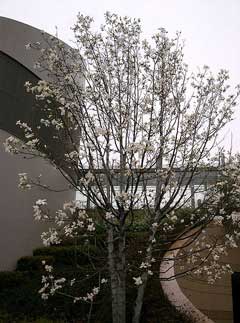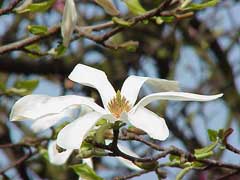 |
|
http://commons.wikimedia.org/wiki/User:KENPEI |
 |
| http://www.biolib.de/ |
Translate this page:
Summary
Bloom Color: Pink, White. Main Bloom Time: Early spring, Late spring, Mid spring. Form: Rounded, Spreading or horizontal.
Physical Characteristics

 Magnolia_kobus is a deciduous Tree growing to 12 m (39ft) by 7 m (23ft) at a medium rate.
Magnolia_kobus is a deciduous Tree growing to 12 m (39ft) by 7 m (23ft) at a medium rate.
See above for USDA hardiness. It is hardy to UK zone 5. It is in flower from April to May. The species is hermaphrodite (has both male and female organs) and is pollinated by Beetles.
Suitable for: light (sandy), medium (loamy) and heavy (clay) soils and prefers well-drained soil. Suitable pH: mildly acid, neutral and basic (mildly alkaline) soils. It can grow in semi-shade (light woodland) or no shade. It prefers moist soil. It can tolerate atmospheric pollution.
UK Hardiness Map
US Hardiness Map
Synonyms
M. precosissima. M. thurberi.
Plant Habitats
Edible Uses
Flowers and flower buds - cooked[177, 183]. The leaves are eaten or used to make a tea[183]. Older leaves are powdered and sprinkled on foods as a flavouring[183].
References More on Edible Uses
Medicinal Uses
Plants For A Future can not take any responsibility for any adverse effects from the use of plants. Always seek advice from a professional before using a plant medicinally.
Treats headaches[174].
References More on Medicinal Uses
The Bookshop: Edible Plant Books
Our Latest books on Perennial Plants For Food Forests and Permaculture Gardens in paperback or digital formats.

Edible Tropical Plants
Food Forest Plants for Hotter Conditions: 250+ Plants For Tropical Food Forests & Permaculture Gardens.
More

Edible Temperate Plants
Plants for Your Food Forest: 500 Plants for Temperate Food Forests & Permaculture Gardens.
More

More Books
PFAF have eight books available in paperback and digital formats. Browse the shop for more information.
Shop Now
Other Uses
Wood - soft, light. Used for engraving, utensils, matches etc[46, 61].
Special Uses
References More on Other Uses
Cultivation details
Landscape Uses:Firewood, Pest tolerant, Specimen. Best grown in a warm position in a moderately rich free soil of an open texture[1]. Succeeds in acid or neutral soils in sun or part shade[184]. Fairly lime tolerant[200, 202]. The branches are brittle so a sheltered position is required[200]. Very tolerant of atmospheric pollution[200]. A very hardy plant, tolerating temperatures down to about -28°c[200]. The fleshy roots are easily damaged and any transplanting is best done during a spell of mild moist weather in late spring[182]. Plants take 10 - 15 years to flower after being planted out[202]. The leaves are slightly aromatic[188]. Very closely related to M. stellata, differing in having 3 narrow sepals and 6 - 9 broader petals. Special Features:Not North American native, Fragrant flowers, Attractive flowers or blooms.
References Carbon Farming Information and Carbon Sequestration Information
Temperature Converter
Type a value in the Celsius field to convert the value to Fahrenheit:
Fahrenheit:
The PFAF Bookshop
Plants For A Future have a number of books available in paperback and digital form. Book titles include Edible Plants, Edible Perennials, Edible Trees,Edible Shrubs, Woodland Gardening, and Temperate Food Forest Plants. Our new book is Food Forest Plants For Hotter Conditions (Tropical and Sub-Tropical).
Shop Now
Plant Propagation
Seed - best sown as soon as it is ripe in a cold frame. Stored seed must be kept cold over the winter and should be sown in late winter in a cold frame[200]. The seed usually germinates in the spring but it can take 18 months. Prick out the seedlings into individual pots when they are large enough to handle and grow them on in light shade in a cold frame or greenhouse for at least their first winter. They can be planted out into their permanent positions when they are more than 15cm tall, though should be well mulched and given some protection from winter cold for their first winter or two outdoors. Layering in early spring[200]. Cuttings of half-ripe wood in early summer[202].
Other Names
If available other names are mentioned here
Native Range
TEMPERATE ASIA: Korea, Japan
Weed Potential
Right plant wrong place. We are currently updating this section.
Please note that a plant may be invasive in one area but may not in your area so it’s worth checking.
Conservation Status
IUCN Red List of Threatened Plants Status :

Growth: S = slow M = medium F = fast. Soil: L = light (sandy) M = medium H = heavy (clay). pH: A = acid N = neutral B = basic (alkaline). Shade: F = full shade S = semi-shade N = no shade. Moisture: D = dry M = Moist We = wet Wa = water.
Expert comment
Author
DC.
Botanical References
1158200
Links / References
For a list of references used on this page please go here
Readers comment
| Add a comment |
|
If you have important information about this plant that may help other users please add a comment or link below. Only comments or links that are felt to be directly relevant to a plant will be included. If you think a comment/link or information contained on this page is inaccurate or misleading we would welcome your feedback at [email protected]. If you have questions about a plant please use the Forum on this website as we do not have the resources to answer questions ourselves.
* Please note: the comments by website users are not necessarily those held by PFAF and may give misleading or inaccurate information.
To leave a comment please Register or login here All comments need to be approved so will not appear immediately.
|
|